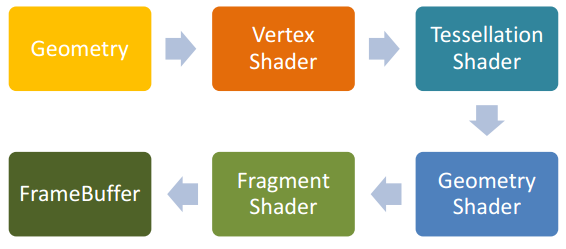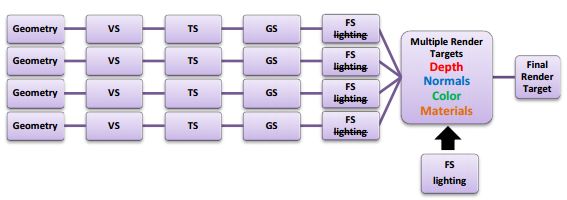The technical foundation of several Rendering Paths in real-time rendering
1. The Technical Foundation of the Rendering Pipeline
Before diving into various lighting rendering techniques, it's essential to understand the modern graphics rendering pipeline, which serves as the foundation for many of the rendering paths discussed below.

Modern game and graphics engines, including underlying APIs like DirectX and OpenGL, now support the programmable rendering pipeline. This pipeline allows developers to customize stages that were previously fixed, such as vertex processing and pixel color calculation. While this flexibility gives more creative freedom, it also requires more implementation effort from the user.
The programmable pipeline typically involves several steps: the user defines vertices that are passed to a Vertex Shader. Optionally, a Tessellation Shader and Geometry Shader can be used for advanced geometry manipulation. After rasterization, the resulting fragments are processed in the Fragment Shader before being sent to the FrameBuffer for display on the screen.
2. Commonly Used Rendering Paths
Rendering paths refer to the methods used to calculate lighting in a scene. With multiple light sources, especially dynamic ones, achieving both performance and visual quality is challenging. As graphics hardware has evolved, different rendering paths have been developed to handle these scenarios effectively.
2.1 Forward Rendering

Forward Rendering is a widely used technique where lighting calculations occur during the Vertex or Fragment Shader stage. Each light source contributes to the final color of the object. In Unity3D 4.x, for example, different light sources may be processed at the vertex or fragment level, or using spherical harmonics for efficiency.

Advantages of Forward Rendering include simplicity and compatibility, but its performance degrades with a large number of lights. For instance, lighting calculations in the vertex shader scale with the number of vertices, while those in the fragment shader scale with the number of pixels. Optimizations like limiting the number of active lights or culling inactive ones can help improve efficiency.
2.2 Deferred Rendering

Deferred Rendering delays lighting calculations until after the geometry has been rendered. It uses a G-Buffer to store material properties such as position, normal, and diffuse color. These values are then used in a post-processing step to compute lighting effects efficiently. This method separates the complexity of lighting from the number of objects, making it ideal for scenes with many light sources.
However, the memory usage of the G-Buffer can be high, especially on lower-end hardware. Additionally, accessing G-Buffer data consumes bandwidth, which can impact performance. Techniques like Light Pre-Pass and Tile-Based Deferred Rendering aim to reduce these overheads by optimizing how light information is stored and accessed.
2.2.1 Light Pre-Pass
Light Pre-Pass is a variation of Deferred Rendering that stores only depth and normal values in the G-Buffer. This reduces memory usage and allows for more flexible material handling. By calculating lighting properties in a separate pass, it combines the benefits of both Forward and Deferred Rendering, offering better performance and visual quality.
2.2.2 Tile-Based Deferred Rendering
Tile-Based Deferred Rendering divides the screen into small tiles and processes each tile independently. This approach reduces the number of lights considered per tile and minimizes G-Buffer access, leading to improved performance. It’s particularly effective for complex scenes with numerous light sources.
2.3 Forward+
Forward+ is an extension of Forward Rendering that incorporates light culling. It begins with a z-prepass to write depth values only, followed by a tiling process to determine which lights affect each tile. Lighting is then calculated in the forward pass, combining the efficiency of Forward Rendering with the scalability of Deferred Rendering.
Forward+ offers a balance between performance and visual quality, making it suitable for a wide range of applications. It leverages modern GPU capabilities to deliver high-quality results without excessive resource consumption.
3. Summary
To compare the different rendering approaches, we can examine the Rendering Equation, which describes how light interacts with surfaces. Forward Rendering calculates lighting for a limited number of light sources, while Deferred Rendering decouples lighting from geometry, allowing for more efficient handling of many lights. Forward+ improves upon Forward Rendering by incorporating light culling, enhancing both performance and flexibility.
3.1 The Rendering Equation
The Rendering Equation models the interaction of light with a surface at a given point. It considers incident light intensity, direction, and the surface’s reflectance properties. This equation forms the basis for all lighting calculations in real-time graphics.

3.2 Forward Rendering
In Forward Rendering, only a subset of light sources is considered due to performance constraints. This can lead to less accurate lighting effects, especially when dealing with complex scenes.

3.3 Deferred Rendering
Deferred Rendering allows for efficient lighting computation by separating the geometry pass from the lighting pass. This makes it well-suited for scenes with a large number of light sources.

3.4 Forward+ Rendering
Forward+ improves upon Forward Rendering by incorporating light culling, enabling more efficient use of resources while maintaining high visual quality.

Labeling Machine,Label Making Machines,Label Sticker Printer,Label Printing Printers
Kunshan Bolun Automation Equipment Co., Ltd , https://www.bolunmachinery.com